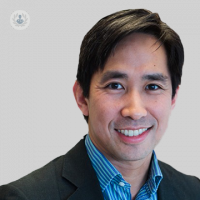The steps of ACL reconstruction surgery
Written by:Patients who wish to return to any leisure or sporting activities that require turning or pivoting movements would benefit from ACL reconstruction. These sports include skiing, tennis, martial arts, football, rugby, badminton, basketball, hockey and similar sports.
Here consultant orthopaedic surgeon Mr Winston Kim explains the process of having ACL reconstruction surgery, from the preparation to the importance of aftercare with rehabilitation.

What happens if I don’t have ACL reconstruction surgery?
The risks of not having ACL reconstructive surgery in patients who enjoy these activities is further damage and injury to the meniscus (soft cartilage which acts as a shock absorber in the knee) other ligaments, damage to the hard cartilage (chondral cartilage) and therefore increased risks of developing early knee arthritis.
Are there different types of ACL surgery?
In general, the replacement graft for ACL reconstruction is obtained either from the hamstring tendon or bone patella tendon graft, which is graft taken from part of the patella tendon. In addition, it is possible to use an allograft (this is a graft obtained from cadaveric tissue). The latter is not popular in the UK due to theoretical risks of infection, higher risk of failure and costs.
Bone patella tendon-bone graft is the favoured graft option for elite athletes as it involves not sacrificing the hamstring tendon, which is key to acceleration/’push off’. The hamstring tendon is also a secondary knee stabiliser. Bone-patella tendon-bone graft allows early accelerated rehabilitation. The disadvantages of bone patella tendon-bone graft are a somewhat larger scar in the front of the knee, compared to hamstring graft, and an altered sensation the on outside aspect of the knee, which tends to improve with time.
However, the advantage of bone patella tendon-bone is an earlier return to sports, marginally superior clinical outcomes, quicker recovery, allowing patients and athletes to return back to their preferred sports.
What are the steps of ACL reconstruction?
Before ACL reconstruction patients are advised to undergo “pre-rehabilitation”. This involves treatment supervised by physiotherapists to ensure patients are fully aware of the type of exercises and conditioning work which is required, for months after surgery.
At surgery, arthroscopy (keyhole surgery of the knee) is performed to examine the knee to ensure a complete ACL rupture is confirmed. The cartilage surfaces are examined and any soft cartilage tears are repaired. The preferred graft (e.g. either hamstring or bone patella tendon-bone graft) is obtained.
Using a keyhole technique, the precise position of the reconstructed graft is identified. Drilled holes are made in the shin bone (tibia) and thigh bone (femur). The graft is passed and secured with fixation devices which is typically either a metal-based screw or button or bio-composite device. After surgery, regular icing and stretches are important as well as relative rest for the first two weeks followed by a gradual return to full activities.
How long does recovery from ACL reconstruction take?
Patients are typically off work two to three weeks after surgery to allow adequate time for icing, stretches and exercises. Patients are on crutches for between two and four weeks after surgery. Functional recovery and return to sports are sport-specific but it will typically take 9 to 12 months before return to pivoting sports.
Do you need rehab after ACL reconstruction surgery?
Rehabilitation is the key to successful ACL surgery. Without rehabilitation, ACL surgery is likely to fail or re-injury is likely to occur. It is important that patients are fully aware of the requirement for intensive rehabilitation both before and after ACL surgery to ensure the best possible outcomes.
Rehabilitation involves a range of movement stretches immediately after surgery, use of an exercise bike, conditioning exercises, improving balance and gradual strengthening exercises. It is important to address neuromuscular factors which predispose individual patients to recurrent injury after ACL reconstructive surgery. This is a long process which requires patient compliance with a range of exercises.
Do not hesitate to book a consultation with Mr Kim if you would like to discuss your treatment options for ACL.


